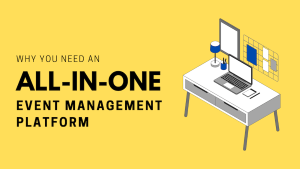
It seems like getting sponsors for a university event is a difficult task, but a strong design approach can turn the whole deal into a smooth and productive one. By designing your sponsorship plan in a clear and directed way, it’s more likely that you will get the support of the brands that are compatible with your event. A sponsor wants to comprehend your worth, your audience, and the experience that you can provide. A good sponsorship pitch design conveys all of this to the user without any misunderstanding.
This manual is about the design of your sponsorship strategy, proposal, and the creation of outreach materials. It is all about the structure, the layout, and the presentation so that you can produce a refined system for locating and obtaining sponsors.
Start by Designing a Clear Sponsorship Framework
It is necessary to have a simple and structured framework before you go to the sponsors with a proposal. This framework is like a roadmap for your proposal, pitch deck, emails, and the brand identity of the event.
Build your framework around these components:
Event Overview:
-
- Make it short and to the point
- Event theme
- Event purpose
- Audience to be reached
- Date and location- on-campus, hybrid, or online
What you have in this section is basically the first section of every asset you create.
Audience Breakdown:
Those who sponsor will be interested to know who the attendees are. Construct a section which features:
-
- Age group
- Academic background
- Interests
- Footfall estimated or online reach
Put this data in charts or small blocks so people will not be tired of going through this information.
Sponsor Categories:
-
- Title Sponsor
- Gold Sponsor
- Silver Sponsor
- Community Partner
- Sponsor support in products or services
Creating these tiers with a clean design that clearly shows the benefits in each category is a good idea. At a glance, sponsors should be able to compare the tiers.
Benefits Structure:
Figure out what you can give in exchange. Those benefits may consist of:
-
- Logo placement
- Speaking slots
- Booth space
- Social media mentions
- Access to student networks
- Branding in printed and digital material
The sponsorship model prepares the ground for the other work of the design team. When this is done, everything becomes easier.
Design an Event That Stands Out Visually
Your event identity is probably the factor that most sponsors will take into consideration when deciding whether you are professional or not. In essence, your brand identity tells a lot about the quality of your event, even before you meet the sponsors.
Build your identity with these points:
Color Palette
Decide on the two or three colors that will mainly characterize your event. Apply those colors in your proposal, presentations, website, and any other material that promotes your event.
Typography
Select neat and uniform font types. Do not use decorative fonts. Always keep in mind that the main thing is readability.
Event Logo
If you have a logo, ensure it is classy so that it goes well with your event’s overall theme. On the other hand, if you don’t have one, attempt to make a simple symbol that uses basic lines and characters that are easy to read.
Visual Style
You might decide on a single style uniform for:
-
- Icons
- Photography
- Layout spacing
- Header size and subheader structure
The presence of a well-structured and consistent identity builds up a strong image of your sponsorship package and shows that it is done in a contemporary and organized manner.
Design a Polished Sponsorship Proposal
A sponsorship proposal is the primary tool of your outreach. It explains the event, the benefits, and the possibilities of the sponsorship. If it is properly designed, it creates a good impression and leaves the sponsors with a positive feeling about your event.
Unique proposal design tips are as follows:
Use a Clean, Single-Column Layout
Don’t visually overload your proposal. Keep it simple with the spacing and single-column design, which is more user-friendly.
Include a Structured Table of Contents
Usually, sponsors only skim through the documents. A table of contents eases their way.
Add Clear Section Headers
Change the look of the document headings by making the text bold, increasing the font size, or even placing a color behind the heading. So, it helps sponsors to quickly go through the proposal.
Use Short Paragraphs
A short paragraph with crisp sentences is one of the ways to hold attention. Do not use large blocks of text.
Present Data Visually
Numbers in graphs, icons, or small charts become clearer. Use them for:
-
- Audience numbers
- Engagement estimates
- Media reach
Compare Sponsor Tiers with a Table
By using a table for viewing, a sponsor can quickly note the differences. Inside the table, you should use checkmarks, icons, or brief words.
Highlight High-Impact Benefits
Each tier’s very first benefit should be your strongest one. Sponsors always look through the top first.
Include Contact Information with a Clear Design
You can assist people in quickly finding your contact information. A boxed layout can be used for that at the end of the document.
A clean and well-structured proposal is your ticket to a response.
Design a Compelling Pitch Deck
With the help of a pitch deck, you can show a short visual version of your proposal to people. Such a piece of work goes well in an online meeting or a face-to-face one. The work done should be brief and point to the issue straight away.
What to do when designing your pitch deck:
Keep Slides Minimal
Presenting one idea per slide is the most effective way. Rather than writing down and using complex figures, one can use a big font and a simple icon.
Use Visual Hierarchy
Highlight key points with:
-
- Italic or bold words
- Color of the text or background
- Font size
Add Photos When Needed
Familiarize the people with real photos of the past events. If it is the first time for the event, use mockups that can best represent your identity.
Use a Strong Closing Slide
Close the pitch with:
-
- The synopsis of advantages
- Main sponsorship request
- Your e-mail, phone number, and address
Your pitch deck is meant to help your proposal, not be a copy of it. Make it crisp and focused.
Design a Sponsorship Landing Page
Posting a simple landing page either on your university site or event platform enables potential sponsors to quickly get to know your event without having to open files.
The main components to sketch out:
Clean Header Banner
-
- Event name
- Event date
- Brief tagline
A Section for Event Highlights: Decorate with icons or small illustrative pieces.
Sponsor Tier Boxes
Prepare a set of neat boxes for each tier. Each box should have:
- Price or range
- Advantages
- Contact button
Contact Form
Include a brief form:
- Name
- Company
- Message
After they have filled and submitted the form, you can handle all sponsors’ requests through Dryfta’s event management tools.
Design an email template for sponsorship outreach
How you design an email is of utmost importance because it is generally the first time you interact with the person. So, put simple, clean, and well-structured text.
Key design guidelines:
Clear subject line
Example: Event Sponsorship Opportunity: Event Name
Short opening
One line is enough, if possible, to express the subject of the email.
Clean body structure
Write in short paragraphs and add spacing between them.
Embedded link or button
You can put your sponsorship landing page link there, or if you have a button such as “View Sponsorship Package,” you can add it.
Signature block
-
- Your name
- Position
- Phone number
Put up a neat block with your information above. This will make your outreach as if you are a well-prepared professional.
Design a Sponsor Follow-Up System
Having a structured follow-up design ensures that everything is kept consistent. These interactions can be managed by you through Dryfta’s built-in email automation and CRM tools.
Describe your follow-up steps as follows:
Thank You Email Template
This is sent when someone expresses their interest.
Meeting Invite Layout
With a short, neat message, you present:
Agenda
-
- Link to meeting
- Time options
Reminder Template
Employing a simple text that recalls the sponsor to the conversation is what you should do.
Having a structured system raises the probability of your conversion because sponsors notice the consistency in your communication.
Design On-Ground Branding Mockups
One of the things that sponsors want to know is what their branding would look like at your event. When you create mockups, you actually give them a picture of the effect their brand will have.
Make mockups for:
-
- Stage backdrop
- Banners
- Standees
- Digital screens
- Social media posts
- T-shirts
- Badges
- Website placements
Similarly, use the event identity for all the mockups. The colors and the spacing should be consistent. Mockups give a feeling of being embraced.
Design Accurate Budget Graphics
Donors love it if you are clear and open. Create an uncomplicated budget picture that indicates:
-
- The things you intend to spend money on
- The reason why you need sponsors
- How their money will be used to help the event
Include:
-
- Circular diagrams
- Histogram
- Brief descriptions of each part of the figure
Design Your Call to Action
Your ad’s CTA should be appealing and clear. The aim is to help the advertisers or sponsors take the next step.
For example: “Be a Sponsor Today- Reach Out to Us for Your Sponsorship Package.”
One of the ways to get a supervisor to act on his or her intention is by employing an engaging CTA.
Final Thoughts
Design is the pivotal element that helps a university event get sponsors. By precisely designing your framework, proposal, pitch deck, landing page, outreach templates, and event identity, you lay down a solid ground for sponsorship success. Sponsors love clarity, organization, and visual consistency. Great design delivers professionalism, trustworthiness, and dedication.
If you are willing to work with sponsors, keep track of communications, create attractive event pages, and be able to organize the whole event flow in a single platform, then Dryfta is the solution that has all the necessary and powerful tools to support your needs. If you want to plan your next university event with complete certainty, Dryfta is the right choice to make. Ask for a free demo and discover how easy it is to plan, execute, and expand your events.




